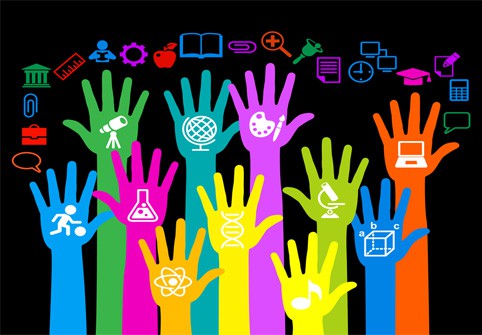5 Ways New Tools & Schools are Transforming Special Education

New tools and new school models are creating the opportunity to better serve students with special needs. “Blended learning has been a big help to our special needs students because it gives us a wider range of content and strategies to meet them at their level,” said Doug Haynes, CEO at Rocky Mount Prep, a K-12 charter school in North Carolina. “They especially enjoy adaptive programs and virtual services such as speech therapy.”
Developing school models that blend the best of online and face-to-face learning holds real promise for better meeting special needs. There are 5 reasons I’m excited about this topic:
1. Inclusion. “At Rocketship Education,” said Genevieve Thomas, “We start with the assumption that all of our kids can be in their general education classroom for the entire day. Then, students are brought out for specialized instruction when their unique learning needs require it. Technology, specifically used in our widely-recognized blended learning model, helps make this possible. Based on a student’s individual needs, we may pull them out for targeted support for short periods of time or use a special app on an iPad to address a specific Individualized Education Plan (IEP) goal. This means each student’s day is customized to fit their needs and abilities.”
Blended models influence inclusion practices. Lab rotation models can provide more time with specialists (e.g., see feature on Rocky Mount Prep) while class rotation models may provide inclusion and fewer transitions between rooms.
“Blended Learning models have allowed special needs to students to be present and fully connected to the classroom community throughout the day, instead of spending large amounts of time removed from their classmates,” said Robin Wise, special service manager for blended schools at K12.
2. Differentiation. “We are implementing a program called eSpark,” added Thomas. “Each of our schools has iPads that are assigned to students with IEPs in kindergarten through third grade. The iPads are programmed with a suite of apps that are customized based on the student’s unique needs. Individual playlists are automatically created for students, so they go into different apps every day based on their playlist. While eSpark wasn’t designed specifically for special education students, we’re finding that it works well with this student population.”
Game-based learning has the potential to boost persistence. Instructional flexibility that provides accommodations for all students is key–and blended environments often afford more opportunities for customization. School culture may be the most important ingredient–a fortified environment of high expectations and strong supports.
3. Better tools. New tools are helping teachers better address special needs. Three examples include:
- Adaptive learning products: Rocketship uses i-Ready, Dreambox, and ST Math
- Augmentative and alternative communication (AAC): The iPad and apps like LAMP Words For Life, a vocabulary app with touch controls, are transforming learning for students on the autism spectrum–a $299 app replaces a $7,000 device and helps thousands of children communicate.
- Social emotional learning: Kimochis teaches kids about emotional intelligence and has proven useful to students on the autism spectrum. Ned the Neuron teaching kids about neuroscience and helps them understand themselves and others. The Social Express, an animated, interactive education curriculum that teaches children how to think about and manage social situations.” Alesha Bishop is a fan of Kid in Story by Locomotive Labs.
Amplification and speech-to-text are a big help for hearing impaired students. Magnification and text-to-speech benefit visually impaired students.
4. Match making. Distributed workforce strategies can better match specialists and special needs–any service, anytime, anywhere. During this school year, PresenceLearning will conduct more than 200,000 live online therapy sessions in public district and charter schools. They even offer online occupational therapy.
5. Personalized pathways. Blended learning can increase chances for inclusion and more dynamic (and possibly shorter duration) IEPs for special needs students. It also making it possible to create an individual plan and pathway for all students.
There are so many great folks that have devoted themselves to building great tools for kids with special needs. Professor Simon Baron-Cohen (yes, Sacha’s brother) directs the Autism Research Centre at Cambridge. Sesame is in on the act–Feel Electric teaches kids how to modulate their emotions with a DARPA-funded version for military families.
Continued progress from primary research (as noted in September) combined with the potential of customized learning appears to have transformative potential for special education and signals that it may be time for a Special Ed App Fund. Some learning disability categories are small but low cost mobile apps makes it much easier to aggregate global demand. For children on the autism spectrum, individual students have specific challenges and respond differently to stimulation–that makes it useful to be able to individually tune an app, but it may also drive up development costs. The combination of higher cost and niche segments has slowed innovation. A fund that combined philanthropic and venture capital could be just the bill. If foundations and donors extracted some of the risk, we’d see more entrepreneurs and investors turn their attention to meeting special needs.
The customized learning revolution is clearly benefiting high achievers, but the biggest impact may be in the learning opportunities created for student with special needs. It is finally becoming possible to finetune learning experiences, build resilience and self-reliance, and power effective communication.
On June 30 in Las Vegas, I’ll be leading a session titled Getting Smarter About SpEd at the National Charter Schools Conference with Doug Haynes, Rocky Mount Prep, and Sydney Quon from LAUSD Charters, the largest district charter school authorizer in the nation with 250 charter schools serving over 130,000 students.
For more on special education, watch this PresenceLearning webinar: Getting Smarter About SPED: 5 Blended Learning Decisions & Implications. For more on the 5 critical decisions that schools need to make, see the updated Blended Learning Implementation Guide.
K12 and PresenceLearning are Getting Smart Advocacy Partners.






0 Comments
Leave a Comment
Your email address will not be published. All fields are required.